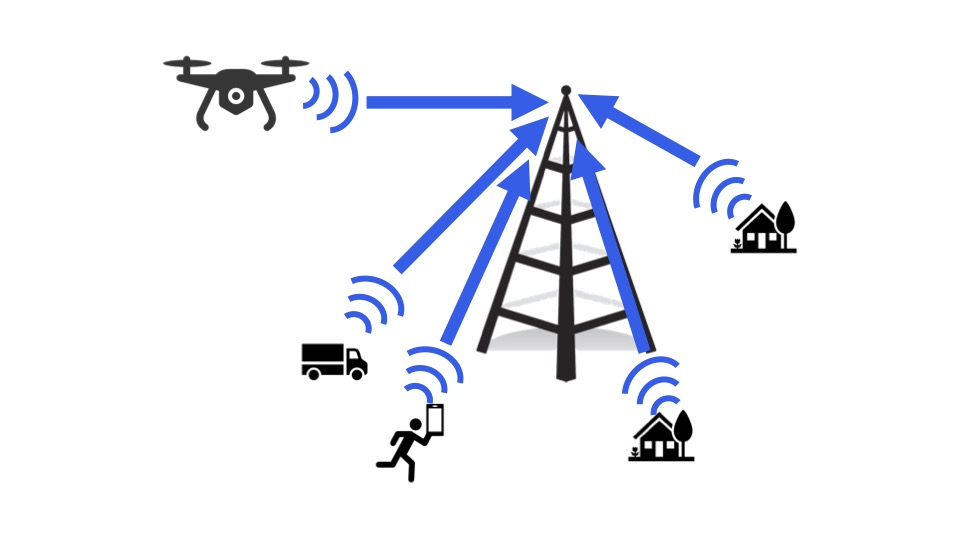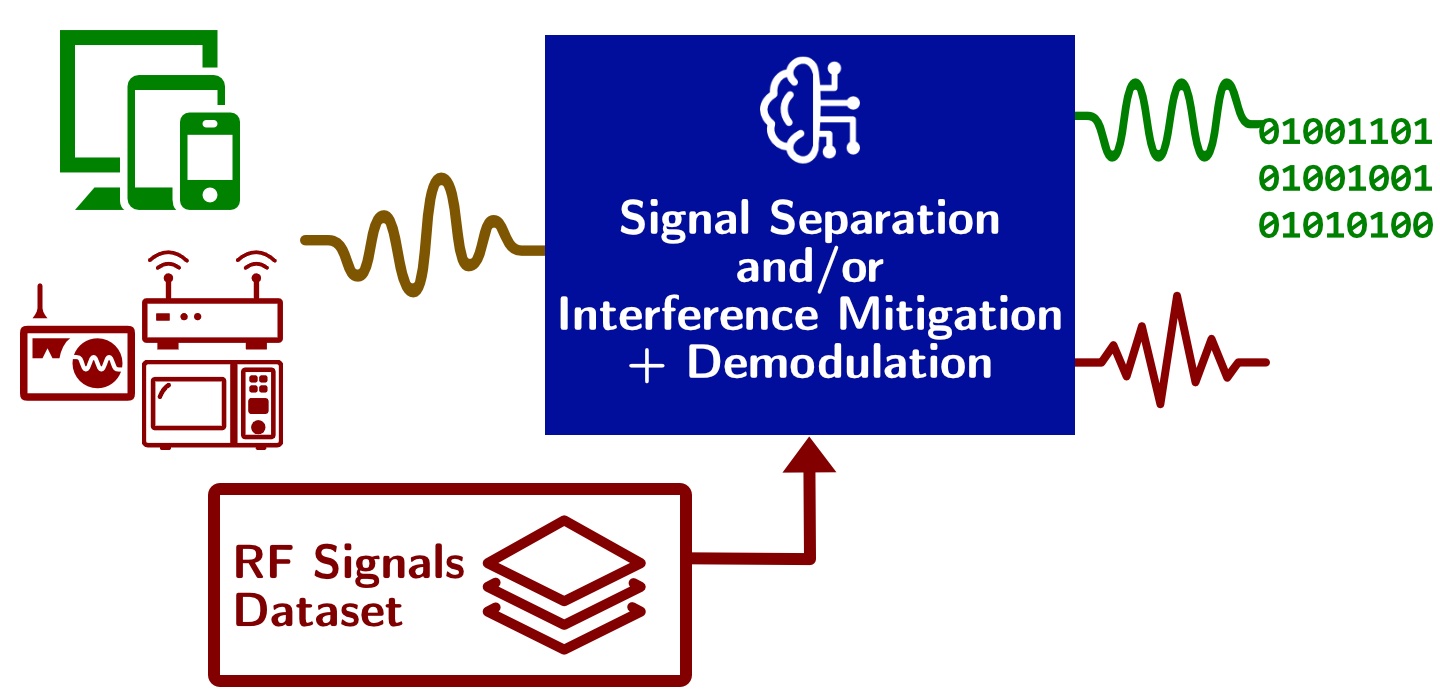S1-2023 Research Highlights
I am thrilled to share an update on the remarkable progress made during the last academic year, thanks to the outstanding collaboration with my talented peers. Together, we have achieved significant milestones in various areas of research. In this blog post, I will provide a summary of our recent published works organized by topic. Let’s dive right in!
Table of Contents
- Unsourced random access
- URLLC communications
- MSE estimation bounds in model mismatch
- Interference rejection via deep learning
Unsourced random access
A. Fengler, A. Lancho, K. Narayanan, Y. Polyanskiy, “On the Advantages of Asynchrony in the Unsourced MAC,” IEEE Int. Symp. Inf. Theory (ISIT), Taipei, Taiwan, Jun. 2023. [arXiv]
In this work, we explore the idea that a lack of synchronization can actually be beneficial in the realm of unsourced random access. Specifically, we investigate a multiple-access problem over a frame-asynchronous 2-user binary-input adder channel in the unsourced setup. Surprisingly, our findings reveal that even a small (or single-bit) shift between users’ frames can enable (random) linear codes to achieve full capacity (0.75 bit per user). Previous research demonstrated that perfect synchronization limits per-user rates achievable with linear codes to 0.5 bit per channel use.
K.-H. Ngo, A. Lancho, G. Durisi, and A. Graell i Amat, “Unsourced multiple access with random user activity,” IEEE Trans. Inf. Theory, Feb. 2023. [arXiv] [IEEExplore] [Matlab code]
In this fascinating study, we build upon Polyanskiy’s random-coding bound for the Gaussian unsourced multiple access channel (UMAC) and extend it to scenarios where the number of active users is random and unknown. The unpredictability of user activity introduces intriguing challenges, and our research sheds light on how to tackle them effectively. For detailed insights into our methodology and results, be sure to explore the full paper.
A. Lancho, A. Fengler and Y. Polyanskiy, “Finite-blocklength results for the A-channel: applications to unsourced random access and group testing,” in Proc. 58th Annual Allerton Conference on Communication, Control, and Computing, Champaign, IL, Sep. 27-30, 2022. [IEEExplore] [arXiv]
Several unsourced multiple access channel (UMAC) schemes divide the available channel uses into sections to apply coding over a relatively small number of channel uses, ensuring reasonable decoding complexity. These codes, known as inner codes, allow the recovery of lists of transmitted sub-codewords per section. However, the challenge lies in properly connecting the estimated sub-codewords from different sections to reconstruct the list of transmitted codewords. This critical task is typically accomplished using outer codes. Here is where the A-channel comes into play. The A-channel is a channel model that enables the establishment of performance benchmarks for outer codes in unsourced random access schemes. In our study, we establish this vital connection and present finite-blocklength bounds on the A-channel. Additionally, we explore the applications of the A-channel in group testing, demonstrating how insights from group-testing schemes can enhance the available outer codes used for UMAC.
URLLC communications
A. Lancho, G. Durisi, and L. Sanguinetti, “Cell-free Massive MIMO for URLLC: A finite-blocklength analysis,” IEEE Trans. Wireless Commun., Apr. 2023. [arXiv] [IEEExplore] [YouTube]
In this work, we present a general framework for the characterization of the packet error probability achievable in cell-free Massive multiple-input multiple-output (MIMO) architectures deployed to support ultra-reliable low-latency (URLLC) traffic. This work is an extension of the results of our previous work [Ostman et al. 2021] for cellular Massive MIMO. Some important conclusions in the design of cell-free architectures for URLLC are: i) minimum mean square error (MMSE) spatial processing must be used to achieve the URLLC targets; ii) for a given total number of antennas per coverage area, centralized cell-free solutions involving single-antenna access points (APs) offer the best performance in the uplink, thereby highlighting the importance of reducing the average distance between APs and UEs in the URLLC regime; iii) this observation applies also to the downlink, provided that the APs transmit precoded pilots to allow the UEs to estimate accurately the precoded channel.
A.O. Kislal, A. Lancho, G. Durisi, and E. Strom, “Efficient evaluation of the error probability for pilot-assisted URLLC with Massive MIMO,” IEEE Journal Sel. Areas Commun., May 2023. [arXiv] [IEEExplore]
In this work, we extend the framework derived in [Ostman et al. 2021] in a different way. Instead of considering a cell-free setup, we remain in the cellular case and analyze the memoryless block-fading channel, in contrast to previous works that focus on quasistatic fading channels. Specifically, the saddlepoint approximation is employed with respect to the number of fading blocks (also known as diversity branches) spanned by each codeword, rather than the number of channel uses per block. This approach proves to be more numerically efficient, and our numerical experiments demonstrate that, when two or more diversity branches are available, the saddlepoint approximation based on the number of fading blocks achieves the same level of precision as the one based on channel uses, while requiring approximately two orders of magnitude fewer Monte-Carlo samples.
A Novel MSE bound for Estimation in Model Mismatch
A. Weiss, A. Lancho, Y. Bu, G.W. Wornell, “A Bilateral Bound on the Mean-Square Error for Estimation in Model Mismatch,” to be presented at IEEE Int. Symp. Inf. Theory (ISIT), Taipei, Taiwan, Jun. 2023. [arXiv]
In this work, we present a bilateral bound on the mean-square error under a general model mismatch. The bound, which is specific to a given (but any) estimator, is applicable in the Bayesian and nonBayesian frameworks to both *biased* and unbiased estimators. Unlike other classical MSE bounds that refer to a model, our bound takes into account the specific estimator of intertest, and is therefore applicable as a tool for characterizing its MSE. In the paper, we present a few of applications of the bound. Also, as an example where the bound can be used to characterize a deep neural network performance is presented in [Weiss et al. 2023] where my colleague Amir Weiss and his coauthors used it in the context of underwater acoustic localization.
Interference rejection via deep learning
The proliferation of wireless devices has resulted in an increasingly congested radio spectrum, where various wireless communication systems coexist within the same frequency bands, inadvertently causing interference between them. Currently, most wireless communication systems employ a matched filter at the receiver to mitigate incoming interference, which is only optimal in terms of signal-to-noise ratio (SNR) when the interference is white Gaussian in nature. However, in scenarios where non-Gaussian signals generate interference, more advanced techniques are required to maintain high reliability.
One promising approach, which is both feasible and practical, involves leveraging available datasets of the underlying communication signals to design data-driven interference rejection solutions. These datasets can be obtained through direct/background recordings or by employing high-fidelity simulators. Deep learning, inspired by its remarkable success in domains such as image and audio processing, emerges as an exceptionally promising solution.
In the following works, we delve into the exploration of the potential gains that deep learning architectures can achieve in comparison to traditional methods like matched filtering:
G.C.F. Lee, A. Weiss, A. Lancho, Y. Polyanskiy, G.W. Wornell, “On neural architectures for deep learning-based source separation of co-channel OFDM signals,” in Proc. IEEE Int. Conf. Acoust., Speech, Signal Process. (ICASSP), Rhodes Island, Greece, Jun. 2023. [IEEExplore] [arXiv] [Python code]
We delve into the study of the single-channel source separation problem involving orthogonal frequency-division multiplexing (OFDM) signals. In this work, we not only assess but also question the effectiveness of employing audio-oriented neural architectures for separating signals based on features relevant to communication waveforms. Additionally, we propose significant modifications to state-of-the-art architectures to ensure their success in this context.
A. Lancho, A. Weiss, G.C.F. Lee, J. Tang, Y. Bu, Y. Polyanskiy and G.W. Wornell, “Data-driven blind synchronization and interference rejection for digital communication signals,” in Proc. IEEE Global Communications Conference (GLOBECOM), Rio de Janeiro, Brazil, Dec. 2022. [IEEExplore] [arXiv] [Python code]
Our research demonstrates the significant performance gains achieved by capturing high-resolution temporal structures, which encompass nonstationarities. This capability allows, for example, for precise synchronization with both the signal of interest (SOI) and the interfering signals. By focusing on this aspect, we uncover valuable insights and contribute to advancing the field.
G.C.F. Lee, A. Weiss, A. Lancho, J. Tang, Y. Bu, Y. Polyanskiy and G.W. Wornell, “Exploiting temporal structures of cyclostationary signals for data-driven single-channel source separation,” in Proc. IEEE International Workshop for Machine Learning and Signal Processing (MLSP), Xi’an, China, Aug. 2022. [IEEExplore] [arXiv] [Python code] (Best student paper award)
Within the scope of this work, we concentrate on cyclostationary Gaussian signals, which accurately model the temporal structure of numerous communication signals. Specifically, we establish a lower bound on the attainable mean squared error (MSE) for any separation or interference rejection method, whether it is model-based or data-driven. As an appealing and computationally efficient alternative, we propose a deep learning approach utilizing a U-Net architecture. Through informed choices tailored to the domain, our proposed method competes with the minimum MSE estimator, positioning it as a compelling solution.



